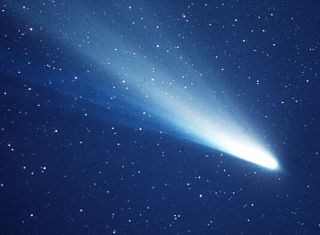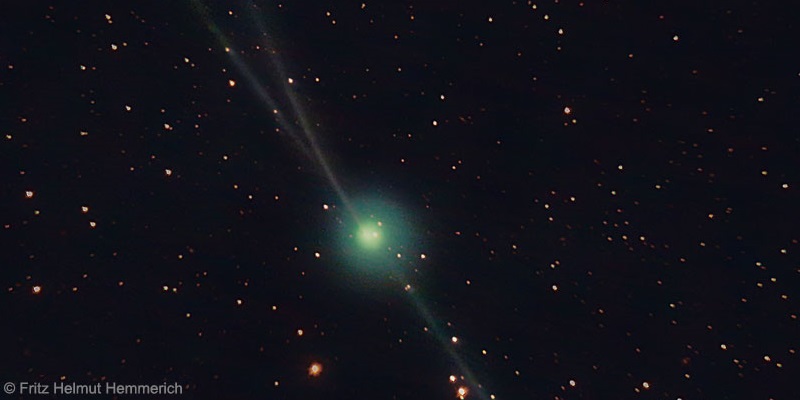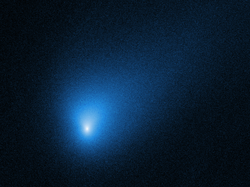
All ancient civilizations have looked upon comets with a sense of trepidation and awe. Comets were considered to be harbingers of doom, disease, and death, infecting men with a blood lust to war, contaminating crops, and dispersing disease and plague.
Ancient Chinese astronomers chronicled numerous episodes where the apparition of comets preceded plague and disaster. It details 29 different commentary forms and the various disasters associated with them, dating as far back as 1500 B.C: "Comets are vile stars. Every time they appear in the south, they wipe out the old and establish the new. Fish grow sick, crops fail, Emperors and common people die, and men go to war.."
A comet is an icy, small Solar System body that, when passing close to the Sun, warms and begins to release gases. This produces a visible atmosphere or coma, and sometimes also a tail. Comets range from few hundred meters to 20 kilometers across and are composed of ice, dust, and small rocky particles.
Is that all they could be composed of?
First century AD. There is an outbreak of a devastating pandemic in Libya, Egypt, and Syria. The cause of the pandemic is bubonic plague caused by the bacillus Yersinia pestis. This bacteria is the causative agent responsible for at least three major human pandemics: the Justinian plague (6th to 8th centuries), the Black Death (14th to 19th centuries) and modern plague (21st century).
What is the origin of these plague-inducing bacillus which periodically infect and kill huge populations over diverse areas, and then reemerge hundreds of years later to attack again?
The keys to unlocking this mystery may include the fact that these microbes are anaerobic (can live without oxygen) and resistant to freezing.
A major anaerobic, freezing environment is located in space.

Halley's comet zooms by Earth once every 76 years or so. It appeared in Earth's skies in A.D. 530 and was astonishingly bright at the time. A new study suggests that piece of the famous Halley's comet likely slammed into Earth in A.D. 536, blasting so much dust into the atmosphere that the planet cooled considerably.
What could have been among those dust particles?
The Black Death (1334-1350AD) for example, has all the hallmarks of a space incident component or trigger. The progression of the disease did not follow the route that people traveled from place to place. Instead it traveled the route as if carried by the winds.This does not accord with straightforward infection via a rodent/flea carrier as is conventional to assume.

In 1908 comet Encke came extremely close to Earth and passed again in 1914.
Also , according to NASA Astrophysics data system files, there was a discovery of an unexpected comet in June 1918 by W. Reid of South Africa. The comet passed closed to the Sun in June at a distance approximately 1,08 the Earth's distance from the Sun.
In 1918 there was a pandemic of influenza ( Spanish flu ) that killed 100 million people worldwide. We know that this epidemic started with birds.
Comet Encke came close to the Earth again in 2007. On April 20th it was struck by a mass of material blasted from the corona of the sun which was so powerful it broke off the comet's tail and swept it away into deep space.
In late June and early July and again in November of that year pieces of comet Encke possibly rained down upon Earth.
In the spring of 2009 a new viral infection began to spread among humans separated by vast distances from one another. On June 11, 2009, the World Health Organization declared the onset of a new pandemic: H1N1, the "swine flu." However, the virus was genetically unique, as its genome consisted of pig genes, human genes, and bird genes.
And finally the outbreak of Covid-19 that was first noted in December 2019 coincided in time with Comet 2I/Borisov

which was the first known interstellar object ever discovered. It was first spotted in summer of 2019 and made its closest pass to the Sun on December 8,2019, 300 million kilometers from our star...
Harbingers of doom?..
Ideas of microbes originating from space belong to professor and Ph.D Chandra Wickramasinghe, who is widely recognized for his work in astronomy and astrobiology and Fred Hoyle, with whom they co-wrote a book in the 1970s called "Diseases from Space".
According to Dr W., in contrast to complex animals and plants, microbes can survive frozen, deep within the permafrost for millions of years. Moreover, microbes which form spores in frozen conditions, might live for billions of years .
In fact they are perfectly adapted for a life on some frozen astral object, traveling through space.
Viruses have been shown to survive simulated extraterrestrial conditions. Moreover, many types of viruses are radiation resistant.
Dr. Wickramasinghe states that when small meteorites break off the comet and fall to Earth – that is in those debris microbes could survive. They could float in the upper atmosphere for years and perhaps infect birds or flying insects. They could travel in Earth's jet streams and then slowly drift downward.
A lot of scientists agree that biological materials could survive on a space rock, noting that organic molecules such as amino acids have been found inside meteorites. Other scientists find Dr Wickramasinghe's ideas pseudo-scientific, although he is a current director of Centre of Astrobiology, UK , professor and honorary professor of few universities, and the list of his scientific degrees is too long to mention here.
Sir Fred Hoyle as you might remember was a famous astronomer, "father of nucleosynthesis" who also coined the name "Big Bang".
Jointly they were awarded a Gold Medal for Science in 1986.
Though Wickramasinghe himself admits that correlation is not causation and thus no firm conclusions could be drawn as there is no scientific evidence to support the idea that viruses come from space.
So let us have open minds but let us not to cross the line between science and hypotheses.
P.S. Richard Hoover (2005, 2006), discovered fungi, algae, cyanobacteria, nanobacteria, spores, diatoms, and protozoan in deep ancient ice cores over 4,000 years old, drilled from Lake Vostok, near the south pole.
These creatures were found in association with ancient cosmic dust particles which had fallen from space...
Rhawn Joseph and Wickramasinghe's 2010 work "Comets and Contagion: Evolution and Diseases From Space" have been used in writing this article